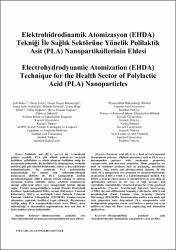Electrohydrodynamic atomization (EHDA) technique for the health sector of polylactic acid (PLA) nanoparticles

View/
Access
info:eu-repo/semantics/openAccessDate
2019Author
Buluş, Erdiİsmik, Deniz
Mansuroğlu, Demet Sezgin
Fındıkoğlu, Maral Selin
Bozkurt, Bahadır
Şahin, Yeşim Müge
Doğancı, Erdinç
Doğancı Dandan, Merve
Sakarya, Gülseren
Metadata
Show full item recordAbstract
Polylactic acid (PLA) is a kind of environmental thermoplastic polymer. Aliphatic polyesters, such as PLA, are a biocompatible polymer with mechanical properties, transparencies and non-toxic properties. These properties are used in consumer products such as packaging, automobile, furniture, food, textile and pharmaceutical industry. In this study, PLA nanoparticle was produced by electrohydrodynamic atomization (EHDA) which is a nanotechnological method. The EHDA system produces micro or nanoparticles by providing an optimization network in the case of high pressure and controllable controllability. Structural properties of the produced nanoparticles (Fourier Transformed Infrared Spectroscopy (FTIR)), thermal (Differential Scanning Calorimeter (DSC)) and morphological (Field Emission Gun Scanning Electron Microscopy (FEGSEM)) characterization studies were made and their properties were determined. PLA nanoparticles with biodegradable properties can be used both as a master and as an additive in clean air filter, tissue engineering and biomedical applications. © 2019 IEEE.

















